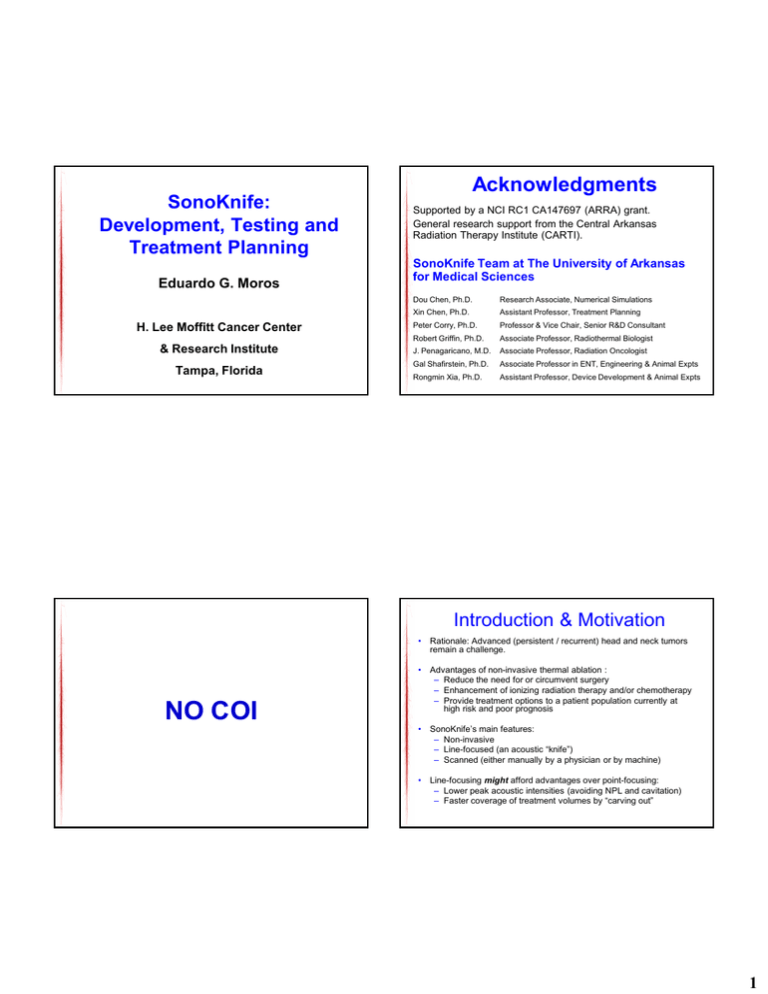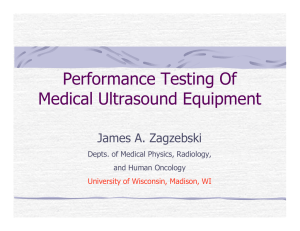Acknowledgments SonoKnife: Development, Testing and
advertisement

SonoKnife: Development, Testing and Treatment Planning Eduardo G. Moros H. Lee Moffitt Cancer Center & Research Institute Tampa, Florida Acknowledgments Supported by a NCI RC1 CA147697 (ARRA) grant. General research support from the Central Arkansas Radiation Therapy Institute (CARTI). SonoKnife Team at The University of Arkansas for Medical Sciences Dou Chen, Ph.D. Research Associate, Numerical Simulations Xin Chen, Ph.D. Assistant Professor, Treatment Planning Peter Corry, Ph.D. Professor & Vice Chair, Senior R&D Consultant Robert Griffin, Ph.D. Associate Professor, Radiothermal Biologist J. Penagaricano, M.D. Associate Professor, Radiation Oncologist Gal Shafirstein, Ph.D. Associate Professor in ENT, Engineering & Animal Expts Rongmin Xia, Ph.D. Assistant Professor, Device Development & Animal Expts Introduction & Motivation • Rationale: Advanced (persistent / recurrent) head and neck tumors remain a challenge. NO COI • Advantages of non-invasive thermal ablation : – Reduce the need for or circumvent surgery – Enhancement of ionizing radiation therapy and/or chemotherapy – Provide treatment options to a patient population currently at high risk and poor prognosis • SonoKnife’s main features: – Non-invasive – Line-focused (an acoustic “knife”) – Scanned (either manually by a physician or by machine) • Line-focusing might afford advantages over point-focusing: – Lower peak acoustic intensities (avoiding NPL and cavitation) – Faster coverage of treatment volumes by “carving out” 1 Simulated Focal Plane Pressure Distributions SonoKnife Radiator Pa Pa 3D 2D R – radius of curvature r - the aperture size L - width of transducer d - position of water/muscle interface f - excitation frequency Radius of curvature R = 60 mm Aperture size r = 60 mm Depth of the array L = 30 mm Depth of water d = 30 mm Frequency f = 3 MHz Transducer surface intensity: 3 W/cm2 Nominal values: R = 60 mm r = 30 mm L = 30 mm d = 30 mm f = 3 MHz SonoKnife: Line-Focused Ultrasound for Thermal Ablation SonoKnife: Line-Focused Ultrasound for Thermal Ablation Step-Scanning Simulations Homogeneous Models Homogeneous Models Temperature and thermal dose distributions on central planes after step-scanning the acoustic edge in the 815 x direction from -15 mm to 15 mm. Focal Plane Temperature & Thermal Dose Distributions for nominal parameter values Max Temperature: ~ 62oC (a) Temperature distribution Frequency f = 3 MHz Radius of curvature R = 60 mm Aperture size r = 60 mm Depth of the array L = 30 mm Depth of water d = 30 mm Emittance: 3 W/cm 2 805 240 100 Thermal conduct: 0.5 W/m/oC Heat capacity: 3720 J/kg/oC Blood perfusion: 5 kg/m 3/s Density: 1138 kg/m 3 Speed of sound: 1569 m/s Attenuation: 0.04 Np/cm/MHz 10 (b) Thermal isodoses • Scanning step: 1.25 mm • No. steps: 24 • For steps 1-3, 4-6 and 7-24, power was on for 5.8 s/step, 5.0 s/step and 4.15 s/step, respectively. • Power-off period of 30 s in-between steps. • Time to complete the entire scan was 797 s. • Nominal parameter values were used except for: emittance = 6 W/cm 3, W b was set to zero at points that reached 240 EM43, and the skin temperature was held at 22°C to simulate forced cooling. • The contours shown in each figure in dark red represent the cumulative 240 EM43 thermal isodoses after the scan was completed. 820 (a) x-z (y = 0) plane (b) x-y (z = 60 mm) plane (c) y-z (x = 13.2 mm) plane 810 825 FIG. 10 FIG. 9 40 41 2 SonoKnife: Line-Focused Ultrasound for Thermal Ablation Comparison of Measurements to Simulations SonoKnife Prototype Transducer y a) Simulated pressure at z = 60 mm b) Measured pressure at z = 60 mm c) Simulated pressure at y = 0 d) Measured pressure at y = 0 e) Simulated pressure at x = 0 f) Measured pressure at x = 0 x z 750 BNC connector Frequency: 3.55 MHz FWHM: 0.5×26×4 mm 755 FIG. 3 34 SonoKnife: Line-Focused Ultrasound for Thermal Ablation a b SonoKnife “Lesions” in Gel Phantoms Ex Vivo SonoKnife Ablations (Porcine Liver) y x c d Z Exposure: 120 W for 30 s. Propagation along z-direction. X (a) Z X (c) Z Y (b) Y (d) x z f e Z y Frequency = 3.5 MHz, Acoustic power = 108 W Depth of Focus = 1.5 cm Exposure times: Top panel: 30 s. Low panel: 20 s. Red arrows: Direction of acoustic radiation z 830 FIG. 11 42 3 Homogenous Simulations & Ex-Vivo Experiments In vivo SonoKnife Ablations (Piglet) Gel Phantom US US 3.5 MHz Transducer 120 W e-power 20 s sonication time Focus at 15 mm under the surface y z Pig’s Liver US oC X = 0 plane 3.5 MHz transducer 3.5 MHz Transducer 108 W e- power 20 s sonication time Focus at 20 mm under the surface Piglet y z In vivo SonoKnife Ablation (Piglet) In vivo SonoKnife Ablation (Piglet) Thigh Neck Skin Skin 21 mm wide Lesion 16 mm long Muscle Fat Muscle 100 W, 60 s Lesion 3.5 MHz 6 mm wide 18.5 mm long 3.5 MHz, 100 W, 40 s 4 Skin Burns Were Observed in Vivo Experiments at 3.5 MHz Lesions 30 Kg Pig’s Neck 100 Watts Electric Power Focus at 22 mm under the skin Sonication time: 40 s Multi-layer Simulated Power Deposition Distribution for the 3.5 MHz transducer Layered-Medium Model and Simulation Parameters • Transducer surface intensity is 3 W/cm2 • A 3D volume pressure is calculated • The thickness of each tissue: Skin – 2 mm Fat – 8 mm Muscle – 40 mm Multi-layer Simulated Temperature Distribution for the 3.5 MHz transducer oC W/m3 X = 0 plane 3.5 MHz transducer Without Attenuation X = 0 plane 3.5 MHz transducer 5 Multi-layer Modeling Shows Two Possible Ways to Reduce Skin Burns In Vivo Ablations: Skin Burns Results at 1 MHz oC X = 0 plane 1.0 MHz transducer without pre-cooling of the skin oC X = 0 plane 1.0 MHz transducer with pre-cooling of the skin to about 8oC In Vivo Results on a Pig’s Neck for a 1 MHz Transducer with Pre-cooling of the Skin Ablation Imaged-Based Treatment Planning Transverse View Ablation Coronal View 44.3 mm 47.5 mm 36.4 mm Transducer Tumor: 30.64 cc Segmentation of anatomical structures (ITK-Snap) Y=0 Transducer Frequency: 1 MHz; Focal depth: 3 cm below the surface; Electrical Power: 92 W; X=0 Sonication Time: 3 minutes; Ice cooling time: 7 min – Placement of acoustic focus for Step-n-Shoot strategy – Start with the deepest zones 6 Treatment Planning Courtesy of Collaborators from http://www.itis.ethz.ch/ Conclusions • Feasible but …. much works remains • Well-defined acoustic edge in simulations and in measurements in aqua, in gel, ex vivo and in vivo. • Step-scanning only demonstrated in simulations thus far. • Skin burns in live piglet: acoustic powers ~100 W (emittance ~1.2 W/cm2): • the thicker the fat layer • frequencies > 1 MHz • focal depth < 1 cm • sonications > 60 s • skin pre-cooling helps • Other potential applications: sonication along (thrombolysis) and/or across vessels (hemorrhage control), subcutaneous sonolipolysis, transcostal therapy, thermal therapy of long bones….. THANK YOU 7 Comparison of a Cylindrical Section and a Spherically Focused Transducers with Equivalent Radiating Areas Line-Focus = Acoustic Edge Spherical Transducer f R (MHz) (mm) r (mm) 3.0 47.95 60 Max press. (MPa) 9 Max inten. (W/cm 2) Avg. inten. (W/cm 2) Acou. edgex (mm) Acou. edgey (mm) Acou. edgez (mm) 2210 1204 0.88 0.88 6.75 Cylindrical Transducer f R (MHz) (mm) r (mm) L Max (mm) press. (MPa) Max inten. (W/cm 2) Avg. inten. (W/cm 2) Acou. edgex (mm) Acou. edgey (mm) Acou. edgez (mm) 3.0 60 30 106 57 0.63 30.9 4.63 60 2 Tissue Properties and Boundary Conditions for Thermal Simulations Thermal conductivity (W/m/oC) Blood Perfusion (Kg/m3/s) Specific heat capacity (J/Kg/oC) Density (kg/m3) Speed of Sound (m/s) Attenuation (dB/cm/MHz ) Water 0.615 0 4180 1000 1500 0.0022 Skin 0.266 5 3430 1200 1498 2.0 Fat 0.223 5 2325 921 1445 0.61 Muscle 0.50 5 3720 1138 1569 0.68 Convective boundary condition at the water/skin boundary is used. For other boundaries, constant temperature 37oC is assumed. 8



